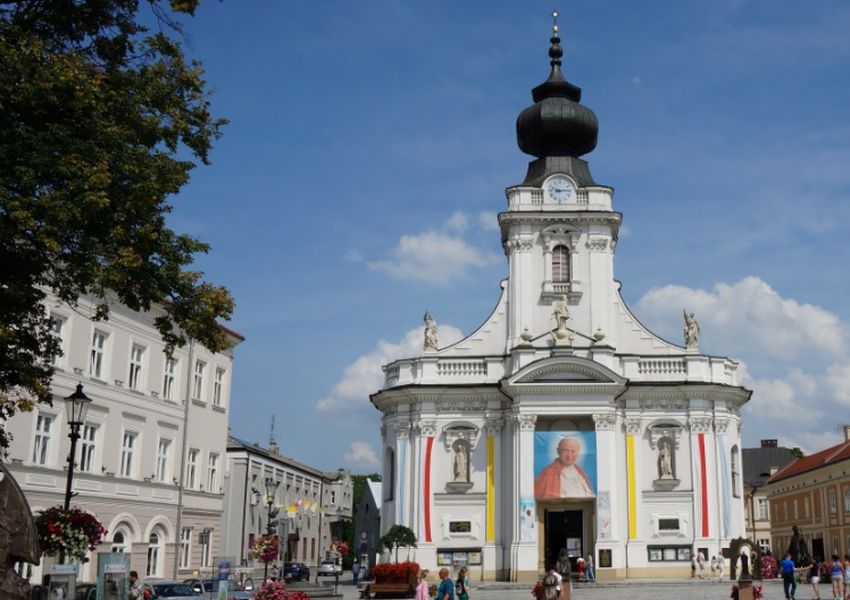In the Footsteps of John Paul II
In the Footsteps of John Paul II
Kraków and Małopolska are the homeland of Karol Wojtyła, Pope John Paul II. From here he set off to Rome for the Conclave which elected him Pope. He loved to return to these places both in spirit and during his papal visits to his homeland: Here, in this land, I was born. Here, in Kraków, I spent most of my life

Here, too, I experienced the grace of the vocation and took the holy orders (...). Here also, in Wawel Cathedral, I was ordained as bishop. In Kraków there are many places connected with the late Pope.
Of these the most central are the Palace of Kraków Archbishops, where he lived and, during his pilgrimages, spoke to the pilgrims gathered at the window (ul. Franciszkańska 3) and the Sanctuary of Divine Mercy in Łagiewniki.
Wadowice is Karol Wojtyła's hometown. The house where he used to live has been turned into a tiny museum. The Church of the Presentation of the Blessed Virgin Mary, where the Pope was baptised, stands right on the market square the very same market square where, in a touching speech in 1999, the Pope recalled his hometown In this town, in Wadowice, everything began life started, school started, studies started, the theatre started, and the priesthood started. Wadowice, Dom Rodzinny Ojca Świętego Jana Pawła II (Family Home of Holy Father John Paul II museum), ul. Kościelna 7.
The grand early-Baroque sanctuary and quiet Paths of Calvary with churches and chapels scattered among the Beskidy hills in Kalwaria Zebrzydowska (13 km/8 miles away from Wadowice along Road 52 to Kraków), listed by UNESCO, are among those sites in Małopolska that Karol Wojtyła visited most often.
As he himself reminisced, he used to come here as a young boy from nearby Wadowice, and later as a priest, bishop, and finally as the Pope, to walk along the Way of the Cross immersed in prayer.
During his 1979 pilgrimage, the Pope mentioned Oświęcim: Oświęcim Auschwitz is an examination of the conscience of humanity through these plaques that testify to the casualties suffered by the nations. Auschwitz is a place that must not be merely visited. Coming here, one must reflect with anxiety on where the borders of hatred lie.
As a young priest, Karol Wojtyła would spend holidays in Raciborowice near Kraków. In these calm surroundings, in the beautiful Gothic parish church founded by historian and royal chronicler Jan Długosz (1415-1480), he studied works by St Thomas. Recalling those days, the Pope said I spent a lot of time in the old church in Raciborowice (...). I meditated for long hours walking in the cemetery. I would also bring my study materials there.
The next place connected with the great Pope is Niegowić, situated 24 km/15 miles away from Kraków. It is here that the young curate was sent to complete his first ministry at the local parish: I remember that (...) when crossing the border of the Niegowić parish, I knelt down and kissed the ground. (...) And that was how my ministry began.
Another region beloved by Karl Wojtyła was Podhale: the highlands at the foot of the Tatras, and the mountains (both the Beskidy and the Tatras). He would say that a man needs this scenic beauty: no wonder, then, that people come here from all over Poland and from abroad.
The Sanctuary of Our Lady the Queen of Podhale in Ludźmierz (4 km/2.5 miles west of Nowy Targ), was often visited by Wojtyła on pilgrimages. In the Neo-Gothic church (1877) he would stop in front of the 15th-c. figure of Our Lady of Ludźmierz carved in wood and affectionately called Gaździna Podhala the hostess of the region.
Ludźmierz lies fairly close to Zakopane, a town where the person of the great Pope is commemorated in many places. One is the Sanctuary of the Holy Virgin of Fatima at Krzeptówki, where Wojtyła held a Holy Mass as Pope (a monument to him commemorates the event). Another is the Chochołowska Valley with the papal hiking trail of the Tatras, which takes you to the sanctuary of St Brother Albert on the slopes of Krokiew, by the broad path from Kuźnice to Kalatówki.
And yet another is the chapel of Our Lady of the Snow at Wiktorówki: a chapel below Rusinowa Polana (glade) hidden among spruce woods, found after an hour's walk along the forest trail, beginning by the road from Zakopane to Wierch Poroniec and further to Łysa Polana.
Another part of Małopolska often visited by Karol Wojtyła was the Sącz Region. One of its centres is Stary Sącz (Road 969 from Nowy Targ), with its medieval Poor Clares convent, established by St Kinga. The nearby Błonia (meadows / common green), were the site of the Holy Mass during which the Pope canonized the Blessed Kinga (1999). Today, a pilgrimage centre stands at its edge with the preserved papal altar.
Info:regiony.gov.pl

































































